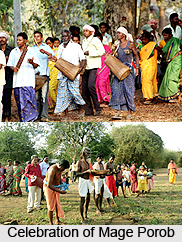 The Hos are the tribe of Jharkhand state and are the fourth most numerous scheduled tribes in the said state after Santals, Oraons, and Mundas. The literal meaning of Ho is `Man`. The `Hos` or the Ho Tribe are mainly concentrated in the Singbhum district of Jharkhand. The Hos are mainly a mountain tribe who are engaged in courtship dances. These dances have sentiments attached to them and are of slow and lackadaisical posturing. These dances are although not highly developed or modernised, they are a source of amusement and much desired occupation of the `Hos` people.
The Hos are the tribe of Jharkhand state and are the fourth most numerous scheduled tribes in the said state after Santals, Oraons, and Mundas. The literal meaning of Ho is `Man`. The `Hos` or the Ho Tribe are mainly concentrated in the Singbhum district of Jharkhand. The Hos are mainly a mountain tribe who are engaged in courtship dances. These dances have sentiments attached to them and are of slow and lackadaisical posturing. These dances are although not highly developed or modernised, they are a source of amusement and much desired occupation of the `Hos` people.
Most of the villages of Hos have an akhra or dancing floor. The akhra usually is a cleared space of hard ground positioned under a scattered tree. Their dances are accompanied by melodious songs. These dances and songs keep on changing with the change of seasons. Various musical instruments accompany their performances which comprise of dama, dumeng, and rutu to name a few.
The Ho Tribe organises several festivals and one of the well known dancing festivals of the Hos is called Mage Porob, organised in the month of Magh. The festivities are organised on a staggered basis in the villages which encourages the participation of neighbouring villagers. Fancy dress competition is also an important part of this ancient dance festival
This article is a stub. You can enrich by adding more information to it. Send your Write Up to content@indianetzone.com



















